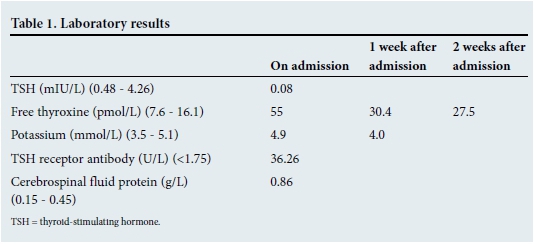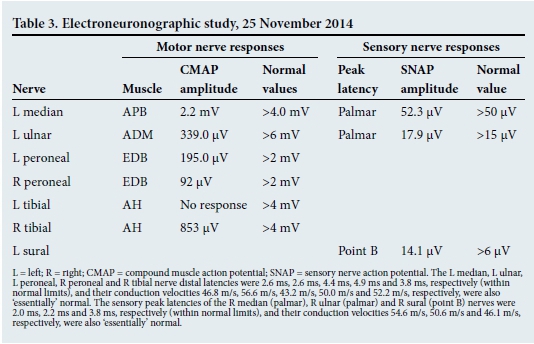Serviços Personalizados
Artigo
Indicadores
Links relacionados
-
 Citado por Google
Citado por Google -
 Similares em Google
Similares em Google
Compartilhar
SAMJ: South African Medical Journal
versão On-line ISSN 2078-5135
versão impressa ISSN 0256-9574
SAMJ, S. Afr. med. j. vol.105 no.10 Pretoria Out. 2015
http://dx.doi.org/10.7196/SAMJNEW.8768
CONTINUING MEDICAL EDUCATION
CASE REPORT
Basedow paraplegia: A possible misnomer
L SmithI; T KempII; C H van der MeydenIII; C-M SchutteIV
IMB ChB, DOH&M, MMed (Int Med), Cert Endo&Metab (SA) Phys;Division of Endocrinology, Department of Internal Medicine, Faculty of Health Sciences, University of Pretoria, South Africa
IIMB ChB, MMed (Int Med), Cert Endo&Metab (SA) Phys, MSc (Clin Epi); Division of Endocrinology, Department of Internal Medicine, Faculty of Health Sciences, University of Pretoria, South Africa
IIIMB BCh, FCP, MD;Department of Neurology, Faculty of Health Sciences, University of Pretoria, South Africa
IVMB ChB, MMed (Neurol), MD;Department of Neurology, Faculty of Health Sciences, University of Pretoria, South Africa
ABSTRACT
Thyrotoxic myopathy frequently occurs in clinical practice; however, the association of hyperthyroidism with a flaccid, areflexic paraplegia, so-called Basedow paraplegia, appears to represent a controversial and doubtful entity.
An 18-year-old female with undiagnosed and untreated Graves' disease presented with acute onset of global weakness predominantly in the lower limbs, but also affecting the upper limbs. The weakness was accompanied by hypotonia and areflexia. Clinically, the patient had a goitre and signs of thyroid ocular disease. Laboratory testing confirmed the presence of hyperthyroidism, and thyroid-stimulating hormone receptor antibodies were positive. The cerebrospinal fluid protein level was raised. The electroneuronographic and needle examinations were compatible with a clear denervation process, such as acute motor axonal neuropathy, a variant of Guillain-Barré syndrome. Intravenous immunoglobulin therapy, carbimazole and propranolol were administered.
The occurrence of hyperthyroidism with a flaccid, areflexic paraplegia appears to represent more of a fortuitous than a causative association. It is important to consider and treat other causes, such as acute idiopathic polyneuritis.
Common neurological complications of untreated Graves' disease include cognitive dysfunction, tremor, ophthalmopathy, myopathy and polyneuropathy. Myasthenia gravis and seizures are uncommon associations, while thyrotoxic periodic paralysis, stroke and chorea occur only rarely.[1]
We present a patient with Graves' disease and the acute motor axonal neuropathy (AMAN) variant of Guillain-Barré syndrome, which masqueraded as so-called Basedow paraplegia.[1-5] Had the diagnosis of Basedow paraplegia been adhered to, the patient would have been denied the opportunity of receiving gammaglobulin therapy.
Case report
An 18-year-old female was admitted in November 2014 with acute onset of severe global leg and arm weakness that had started 4 days before her admission. There was a background history (over the previous 11 months) of proptosis, dyspnoea on exertion, palpitations, irritability and forgetfulness. General examination revealed tachycardia and a symmetrical diffusely enlarged goitre. Proptosis and lid lag were also present. Neurological examination revealed motor weakness, with her legs more affected than her arms. There was global hypotonia and deep tendon areflexia, with sparing of all sensory modalities. Blood tests confirmed the clinical suspicion of hyperthyroidism. Serum potassium levels were repeatedly normal (Table 1), urine porphobilinogen screening was negative and antiganglioside antibodies were absent.

The electroneuronographic studies ofll and 25 November 2014 showed significantly decreased compound muscle action potential (CMAP) amplitudes and preserved sensory nerve action potential (SNAP) amplitudes, with normal distal latencies and conduction velocities, favouring a diagnosis of an AMAN variant of the Guillain-Barré syndrome (Tables 2 and 3). Needle examination of the tibialis anterior muscle on 25 November 20l4 showed the presence of fibrillation potentials and clear neurogenic polyphasic motor units.


A 5-day course of intravenous immuno-globulins, 24 g/day, was administered. Carbimazole was prescribed at 20 mg 8-hourly, and on the development of a skin reaction the dose was decreased to l0 mg 8-hourly. Propranonol was administered at a dose of 20 mg 6-hourly. The thyrotoxicosis gradually improved, but the patient's neurological condition had only marginally improved at the time of discharge.
Discussion
Joffroy coined the term Basedow paraplegia in 1894, after Charcot had referred to 'paraplegia like weakness' in severe hyper-thyroidism in 1889.[3] Joffroy went on to describe the concept as follows: 'A flaccid paraplegia with absent reflexes, minimal or no sensory disturbance, and absent sphincter disturbances,[3] which Pandit in 1998 commented 'could very well fit the description of acute post infective polyneuritis'.[3] Feibel and Campa[2] used the term 'thyrotoxic neuropathy (Basedow paraplegia)' in 1976 and Pandit,[3] in 1998, published a report 'Acute thyrotoxic neuropathy - Basedow's paraplegia revisited,' with the suggestion of an implicit causal relationship between the hyperthyroidism and the neuropathy. However, on closer scrutiny this association may well be fortuitous.
Descriptions of Basedow paraplegia[1-5] appear to conform to the development of an 'acute flaccid paraplegia with absent reflexes' against the background of hyper-thyroidism. It is, however, possible that this clinical presentation may reflect the occurrence of an acute idiopathic polyneuritis,[6] possibly associated with an underlying predisposition to autoimmune diseases.[1]
The association between hyperthyroidism and acute flaccid areflexic neuropathy receives little credence in the following well-known clinical textbooks: Dyck and Thomas' Peripheral Neuropathy[7] comments on its uncertain association and the difficulty to distinguish it from acute idiopathic polyneuritis; Bradley's Neurology in Clinical Practice[6]refers to its association as fortuitous; and Williams's Textbook of Endocrinology[9] and Harrison's Internal Medicine[10]do not even mention the association.
Conclusion
It is important to consider the occurrence of other treatable causes of motor paralysis in patients with Graves' disease, such as acute idiopathic polyneuritis presenting with a rapid onset of flaccid paralysis. The entity of Basedow paraplegia as a diagnosis, per se, was found to be misleading.
Acknowledgements. We thank Mr Sagren Naidoo for his valuable assistance.
References
1. Rubin DI, Aminoff MJ, Ross DS, Wilterdink JL. Neurologic manifestations of hyperthyroidism and Graves' disease. In: Basow, ed. UpToDate. Waltham, MA: UpToDate, 2013. [ Links ]
2. Feibel JH, Campa JF. Thyrotoxic neuropathy (Basedow's paraplegia). J Neurol Neurosurg Psychiatry 1976;39(5):491-497. [ Links ]
3. Pandit L, Shankar SK, Gayathri N, Pandit A. Acute thyrotoxic neuropathy -Basedow's paraplegia revisited. J Neurol Sci 1998;155(2):211-214. [http://dx.doLorg/10.1016/S0022-510X(97)003134] [ Links ]
4. Sanghvi LM, Gupta KD, Bauerjee K, Bose K. Paraplegia, hypokalaemia and nephropathy, with muscle lesions of potassium deficiency, associated with thyrotoxicosis. Am J Med 1959;27:817-823. [ Links ]
5. Fridberg DL, Egart FM. 'A case of Basedow's paraplegia.1 Probl Endokrinol (Mosk) 1970;16:38-40. [ Links ]
6. Bronsky D, Kaganiek GI, Waldstein SS. An association between the Guillain- Barré syndrome and hyperthyroidism. Am J Med Sci 1964;247(2):196-200. [ Links ]
7. Pollard JD. Neuropathy in diseases of the thyroid and pituitary glands. In: Dyck PJ, Thomas PK, eds. Peripheral Neuropathy. 4th ed. Philadelphia: Elsevier Saunders, 2012:2043-2044. [ Links ]
8. Aminoff MJ, Josephson SA. Neurological complications of systemic disease: Adults. In: Daroff RB, Fenichel GM, Jankovic J, Mazziotta JC, eds. Bradley's Neurology in Clinical Practice. 6th ed. Philadelphia: Saunders Elsevier, 2012: 894-915. [ Links ]
9. Davies TF, Larsen PR. Thyrotoxicosis. In: Kronenberg HM, Melmed S, Polonsky KS, Larson PR, eds. William's Textbook of Endocrinology. 11th ed. Philadelphia: Saunders Elsevier, 2008:333-375. [ Links ]
10. Amato AA, Brown RH. Muscular dystrophies and other muscle diseases. In: Longo DL, Kasper DL, Jameson JL, Fauci AS, Hauser SL, Loscalzo J, eds. Harrison's Principles of Internal Medicine. 18th ed. New York: McGraw-Hill, 2012:3487-3509. [ Links ]
Corresponding author: L Smith (drlizlsmith@gmail.com)














